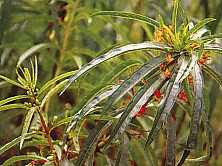
(Clerodendron indicum [L.] O. Ktje.)
Synonym:
C. fortunatum L., C. siphonanthus R. Br., C. lividum Lindl.
Family:
Verbenaceae
Description:
Genje grow wild in the woods and fields. Sometimes planted in the yard near the fence. This plant can be found in places where exposure to sunlight or shielded in a lowland until height of 1200 m above sea level. Tall erect shrubs with stems 1-3 m are green round, longitudinal cracks, hollow center, branching simpodial. Leaves single, short-stemmed, where the craggy. Leaf blade lancet shape, spike, base narrow, flat edge, pertulangan pinnate, glossy dark green color, length from 7 to 15 cm, 3-4 cm wide. Compound interest, the form of an umbrella, out of the armpit and the tip of the leaf stalk, crown shape tube, 1-1.5 cm long, white color. Fruit stones, oval, brown. Black round seeds.
Local Name:
NAME OF Indonesia: biduyuk, marijuana, memadatan (Jakarta). Sumatra: Ronggo Dipo (Palembang). ) image: genje (Sunda), leaves, poppy, sekar quadrats (Java). NAME OF FOREIGN Chang guan li jia mo (C), glorybower (I). NAME Simplisia Clerodendri indici Folium (leaf genje), Clerodendri indici Radix (root genje).
Curable Disease:
It tasted bitter, its cool. Potent anti-inflammatory, analgesics fever (antipyretic), pain relievers (analgesics), and antibatuk (antitusif).
Utilization:
PART USED
Plant part used as medicine are the leaves, and roots. After being washed, cut into thin roots, and drying.
INDICATION
Leaves and roots are used for the treatment genje:
-inflammation of the urethra, bladder inflammation,
-inflammation of the airways (bronchitis), sore throat,
-oral cavity pain, hernia pain, stomach pain,
-strain, bruises, rheumatism,
-fever, influenzae,
-pulmonary tuberculosis, and
-shortness of breath (asthma).
HOW TO USE:
For drugs taken, boiled 15 to 30 g of leaves or roots dry genje, then drink the water. For external use, wash the fresh leaves sufficiently, then milled until smooth. Paste the sick place, such as sprains, bruises, rheumatism, ulcers, purulent inflammation of the skin, and dressing.
EXAMPLE OF USE IN THE COMMUNITY
1. Inflammation of the urinary tract and bladder inflammation
Provide genje leaves and grass snake tongue (Hedyotis diffusa Willd.) In the form of dry material (each of 30 g). Wash, then boil with three glasses of water until the remaining one cup. Once cool, strain and drink the water again sekaligus.Rebus dregs to drink in the afternoon.
2. Shortness of breath
Roll genje dried leaves (to taste), such as cigars. Burn the ends, and then suck.
3. Fever in children
Boil dry genje roots (10-15 g) with three glasses of water to the remaining one cup. Once cool, strain and drink as well. Do it 3-4 times a day until healed.
Note: Clerodendron equal to Clerodendrum.
Composition:
Leaves contain alkaloids, saponins, and polyphenols. Roots and bark contain saponins and flavonoids. Roots also contain polyphenols.
Monday, December 21, 2009
Genje
Diposkan oleh Ariyawan di 12:23 PM
Subscribe to:
Post Comments (Atom)

0 komentar:
Post a Comment